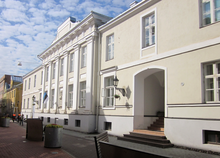Secondary school
A secondary school describes an institution that provides secondary education and also usually includes the building where this takes place. Some secondary schools provide both lower secondary education (ages 11 to 14) and upper secondary education (ages 14 to 18) i.e. levels 2 and 3 of the ISCED scale, but these can also be provided in separate schools, as in the American middle and high school system. In the UK, most state schools and privately-funded schools accommodate pupils between the ages of 11-16 or 11–18. Some elite UK private schools, i.e. public schools, admit pupils between the ages of 13 and 18.[1][2][3]
Secondary schools follow on from primary schools and prepare for vocational or tertiary education. Attendance is usually compulsory for students until age 16. The organisations, buildings, and terminology are more or less unique in each country.[4][5]
In the ISCED 2011 education scale[6] levels 2 and 3 correspond to secondary education which are as follows:
Within the English-speaking world, there are three widely used systems to describe the age of the child. The first is the 'equivalent ages'; then countries that base their education systems on the 'English model' use one of two methods to identify the year group, while countries that base their systems on the 'American K-12 model' refer to their year groups as 'grades'. The Irish model is structured similarly to the English model, but have significant differences in terms of labels. This terminology extends into the research literature. Below is a convenient comparison [7]
Schools exist within a strict legal framework, where they may be answerable to the church, the state through local authorities and their stakeholders. In England (but necessarily in other parts of the United Kingdom) there are six general types of state funded schools running in parallel to the private sector. The state takes an interest in safeguarding issues in all schools. All state-funded schools in England are legally required to have a website where they must publish details of their governance, finance, curriculum intent and staff and pupil protection policies to comply with ' The School Information (England) (Amendment) Regulations 2012 and 2016 '. Ofsted monitors these.[8][9]
School building design does not happen in isolation. The building (or school campus) needs to accommodate:





